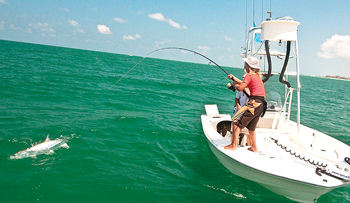Photograph/video your catch

rUSTY CHINNIS | sun
A crooked horizon leads the viewers eye away from the action.
In the digital age, anglers have a plethora of ways to record and share the excitement of their catch. There was a time when it was common to take fish back to the dock, where they were unceremoniously nailed to a board and photographed with the smiling anglers and guide. Occasionally, a picture was taken on the boat, and rarely the fish was released to fight again.
Fortunately, these days, that scenario is rare. Over the years anglers have come to recognize that fish stocks aren't unlimited and have started to release their catch (keeping only what they take home to eat fresh). Practicing catch and release doesn't mean you can't enjoy the thrill of the catch and share it with others.
With the wide spread use of the internet and sites like Facebook, Flicker, Twitter and YouTube anglers can reach out to an almost unlimited audience. Today's digital cameras, including those in smart phones, allow anglers to capture images and/or video of our catches, making catch and release all the more rewarding.
Photography (including videography) has never been easier, and anglers can enjoy this remarkable technology no matter what their level of expertise. Most digital cameras and most smart phones have the ability to capture quality images and video. Many even come with software or apps that let you crop, resize, enhance and share the final product. You can send the images via e-mail straight from a phone or download them, edit and print them out to frame and display. You can also post them online to reach a wider audience.
While taking a picture or shooting a video may be easy, there are a few basic rules that will help anglers produce a better outcome.
• Before ever leaving the dock be sure you have fresh batteries, that phones are charged, memory cards with enough space to record your images, a clean lens and a cleaning cloth.
• You can expect things to get a bit frantic when a memorable fish comes aboard, so get an idea in advance of where you'll pose with your catch.
• Check the area and carefully search for distracting and cluttered backgrounds. One common mistake is to snap a picture with a rod appearing to stick out of someone's head.
• Capture photographs and video that aren't posed. Capture the image as soon as possible. The quicker you get your picture the more vibrant the colors of a fish will be. First and foremost, fill the frame with the subject, eliminating anything that doesn't add to the composition.
• If you plan on creating a slide show or video take images and clips that tell the story of your day on the water.
• Check that the horizon is straight. Most cameras and many phones have a grid to help you get it straight. This is particularly important when shooting vertical images.
• Check the exposure every few minutes, and if you have the option, shoot in aperture priority with at least an F8 setting. If you're trying to catch a jumping fish, you can freeze the action using the shutter priority setting and at least a 1/1000 second exposure.
• Many photographs taken on the water are exposed in bright light. A camera's light meter averages light over the scene, so an angler's face, especially if shaded by a cap, will often be dark and lack detail. Make sure you expose your shots with fill flash.
• If you have photo editing software like Lightroom or Photoshop Elements, you can lighten the shadows in post-production. This can sometimes eliminate the need for fill flash, if the contrast isn't too great, and prevents a flash from creating unwanted reflections on fish.
• Take a number of shots from different angles, and get the angler excited and talking to you. One of the really great advantages of digital is that you can take lots of pictures and view them on the go to make sure you have the shot you want.
• Since lighting is almost always challenging, shoot and then review important shots.
• If you have a more advanced camera, you can bracket important shots in difficult lighting situations. Expose at least three images: one slightly (one stop) underexposed, one slightly (one stop) overexposed, and one at the setting suggested by the light meter.
There are a lot of excellent digital cameras on the market today. The new smart phones can take amazing images, but they have their limitations. If you're really interested in photography get the best camera you can afford. Most come with a trial version of an image editing software like Adobe Elements. There are many cameras on the market, ranging in price from a few hundred to thousands of dollars. Taking the time to capture the moments of life allows you to relive the experience and share it through your images and video.
For more information on the right camera for you, check with a professional at your local camera shop. Locally, I would suggest Johnson PhotoImaging www.jpiphoto.com .
To get started, you can browse the internet for news, products and reviews. Sites like B&H Photo www.bhphoto.com and Amazon www.amazon.com are good places to start. Trial versions of software (Lightroom, Photoshop and Photoshop Elements) can be downloaded at www.adobe.com.
The next time you're on the water, think ahead and plan how you'll capture the thrill of the experience. Whether you use an advanced digital camera or your phone, you'll have a record of your trip that can be enjoyed for years to come.

